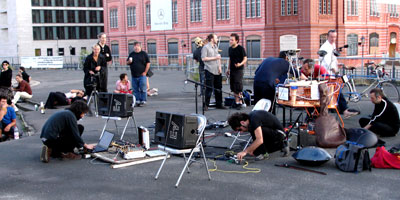Archive for October, 2006
Nick Cave at Jack Shainman Gallery, Chelsea
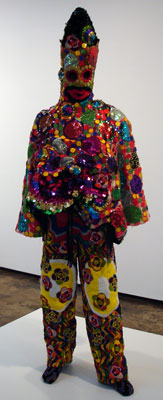 |
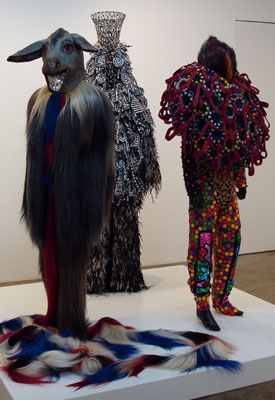 |
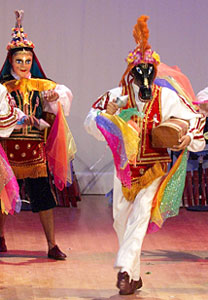 While checking out galleries this past Friday, I was fortunate to walk along 20th Street and immediately be drawn into Jack Shainman Gallery by Nick Cave’s “Sourndsuits.” Cave creates incredibly beautiful and detailed visual confections as costumes and wall pieces. At first I was reminded of Jim Drain’s incredible costumes, but Cave’s work seems to draw more directly from ritualistic costumes of other cultures. For example, a costume with a donkey head immediately reminded me “El Macho Raton” one of the characters from El Gueguense, a Nicaraguan folkloric play, pictured to the right. While checking out galleries this past Friday, I was fortunate to walk along 20th Street and immediately be drawn into Jack Shainman Gallery by Nick Cave’s “Sourndsuits.” Cave creates incredibly beautiful and detailed visual confections as costumes and wall pieces. At first I was reminded of Jim Drain’s incredible costumes, but Cave’s work seems to draw more directly from ritualistic costumes of other cultures. For example, a costume with a donkey head immediately reminded me “El Macho Raton” one of the characters from El Gueguense, a Nicaraguan folkloric play, pictured to the right.
In the gallery presentation, Cave co-opts ethnographic displays of natural history museums. He is at once playing the role of author and ethnographer. As I walked out, my friend Isabel and I wondered if he was merely capitalizing upon the culture of others. However, in investigating Nick Cave’s work, there seems to be a lot more to these costumes. Cave designs them for performance, they are part of an ongoing series that will come alive on stage. |
|
 |
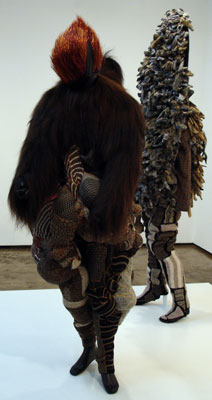 |
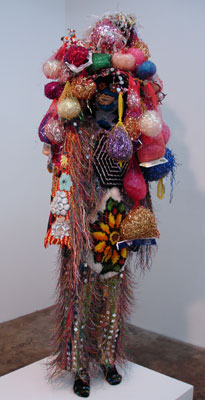 |
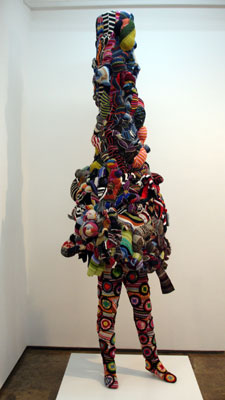 |
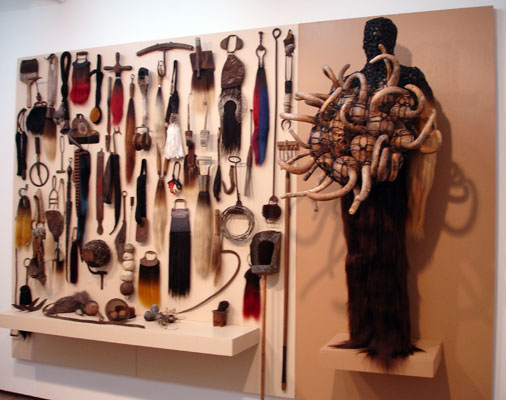 |
|
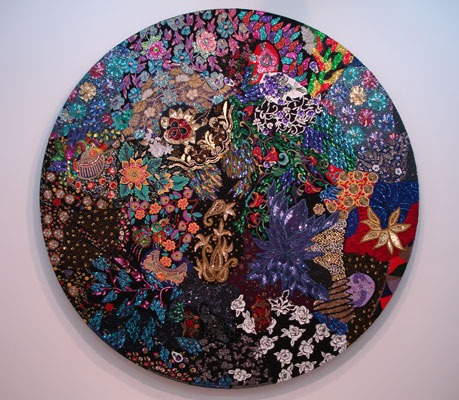 |
|
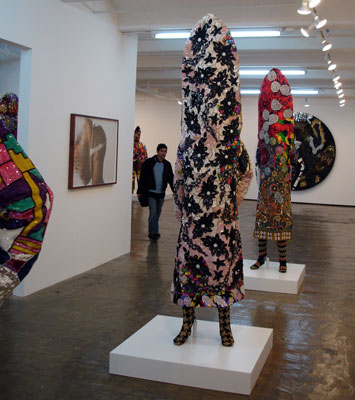 |
|
Copa Sonar Recordings Available
August 07, 2006
Schlossplatz was once the home of the Berlin City Palace. In 1950 the palace, a symbol of Prussian pride and wealth was demolished by the GDR and erected in its place was the Palast der Republik. Due to the combination of the reunification of Berlin and the use of asbestos, the Palace of the Republic is being deconstructed and soon the old palace, Stadtschloss will be rebuilt.
Schlossplatz has historically been a highly contested site. On July 14th it became a site of public performance, sound broadcast and celebration.
Copa Sonar was organized by Marco Barotti, Emanuele Guidi and myself in collaboration with sonambiente, and tesla. Five experimental sound groups volunteered to overtake the desolate public plaza off of the touristic street Unter din Linden. Performances by ap/xxxxx, B Component, the rottt (the return of the thinking thing) and lekronk, OLYVETTY, saal-c were broadcast from the site via miniFM and visitors were offered free wine and beer. The audience was a diverse mix of sound art connoisseurs, curious tourists, and skaters.
The recordings from the event are now available as mp3s and high quality aifs to download – Copa Sonar. Enjoy the data tranformed into noise by ap/xxxxx; the relaxing sound of a Swiss precussion instrument electronically modulated by B Component; electronic and computer experimentation by the return of the thinking thing; Olyvetty’s trans-like performance or the more melodic compositions of saal-c.
Also read an interview concerning the public intervention with Emanuele Guidi.
Copa Sonar 14 July 7-9PM, Schlossplatz, Berlin
July 13, 2006
As sonambiente, the festival for hearing and seeing wraps up, the Public Broadcast Cart will be used for a free outdoor concert of noise and experimental music featuring ap/xxxxx, B Component, saal-c, OLYVETTY, the rottt (the return of the thinking thing) and lekronk.
Copa Sonar, Friday 14 July, 7-9pm at Schlossplatz off of Unter din Linden, Berlin mitte. Free beer and wine will be served.
Organized by Marco Barotti and Emanuele Guidi in collaboration with sonambiente.
sonambiente berlin 2006 – old Polish Embassy
July 04, 2006
The group of projects featured at the old Polish Emabssy on Unter den Liden, I believe comprises the strongest set of works of sonambiente. From low-tech to high, from highly socially oriented works to articulations of new forms of mapping our Earth, the Polish Embassy features a wide array of art for seeing and listening. I will only discuss the ones that I most enjoyed.
Amongst the most powerful works on display in sonambiente is Artur Zmijewski’s “Our Songbook” (2003), a video that collapses social history with subjective memory or more appropriately the fading of personal memories and national identity due to war and social misconduct. “Our Songbook” features elderly Polish Jews who emigrated to Israel during or after WWII, now nearing the end of their lives at a nursing home in Tel Aviv. Upon visiting with these people, the Polish artist asked them to try and recall Polish songs of their youth. Few remember the entire songs, some only recall the refrain. The video is stirring and reflects the pain of dislocation, even after several decades. As I am someone like so many others today who grew up between two countries and does not necessarily feel a strong sense of nationalism, the video is awe striking due to the well-embedded desire to rekindle the actors’ sense of nationalism.
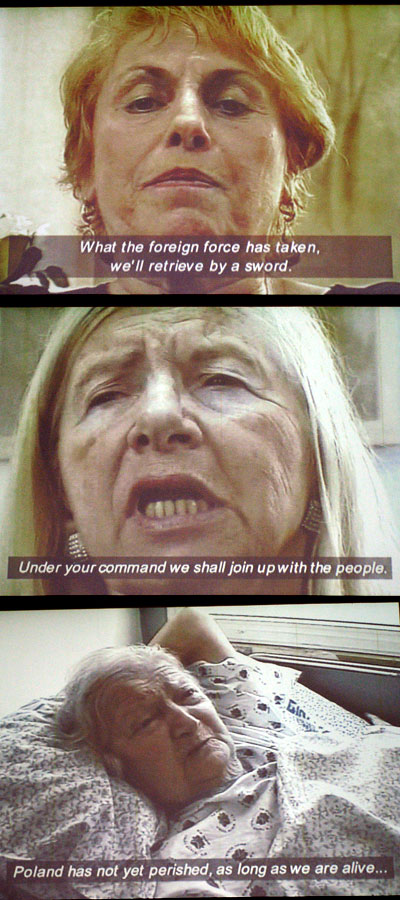
Artur Zmijewski, Our Songbook [2003], video stills
In a small dark room, lit only by small green LEDs that spotlight several digital screens mounted on the walls, Nic Collins has brought wreckage upon several cheap, noisy, hand held electronic games, the sort that are abundant in China Town. Collins tears away the plastic housing, manipulates the electronics, cables the screens so that they may be featured on the walls at an angle. The dancing cubes of the screens are lit by small LEDs that create a shadow play behind the screen. These screens are only connected to their brains by alligator clamps. Heaped in one corner of the room are all the electronics, the plastic housing and a blurbing speaker. Cheap, low-tech and messy, Collins transforms these repetitive, uninteresting, time-killing gadgets into an alluring installation – “no part of an eviscerated toy goes to waste.”

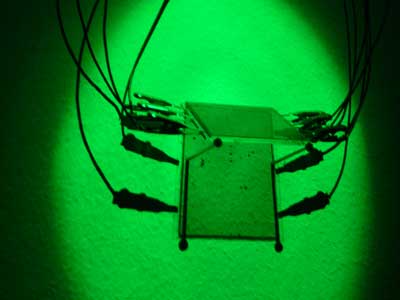
Nicolas Collins, Daguerreotypes 2006
Achim Wollscheid has animated the second story windows facing the tourist filled Unter din Liden as they open and close according to the movement of the viewers in the second story corridor. ” A program traslates the data gained by motion tracking into a correlative action of the mororized window openers.”
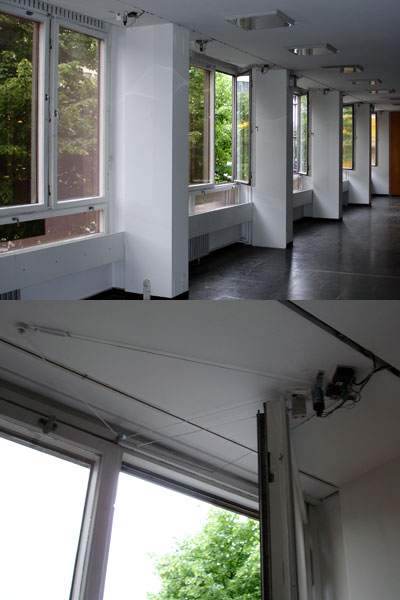
Achim Wollscheid, inlet outlet 2006
Both the larger GP4 (Global Player 04) and it’s much smaller sibling GPod are on display transmitting the sounds of the Earth. Jens Brand has made audible the real-time data of over 1500 satellites so that you may listen to the Earth in the comfort of your home or now with GPod while you are on your way to work or jogging. The GPod displays 3D model of the Earth, along with the coordinates tracked by the satellite that you select. You may listen to the low rumble of canyons or the high pitch of mountain peaks. Anything may be converted to data, mapped and computationally manipulated, the end result is left to the producer’s imagination.

Jens Brand, GPod
Another personal highlight of this festival is my discovery of Joanna Dudley, an extraordinary, multi-talented and powerful artist. I write this not so much because of her installation at the old Polish Embassy, which I did enjoy, but moreso due to further research into her work and the concepts and approaches described in her more theatrical exploits, so please have a look at her site! I haven’t seen her perform, so I might be mistaken, but based on the documentation the work seems very exciting.
The installation “Tom’s Song” (2006) is quite stirring for several reasons, the music is beautiful, the story behind the music is heart warming, it is technically involved and it is all analog! At the core of the installation is a song, “It’s June in January” sung by an older man Tom who also plays the ukulele as he sings. The floor of the installation is covered by portable LP players, each LP player is an individual element of an orchestra assemble to accompany Tom singing his song. From the ceiling hang music boxes that play paper scores to also accompany Tom. Full description
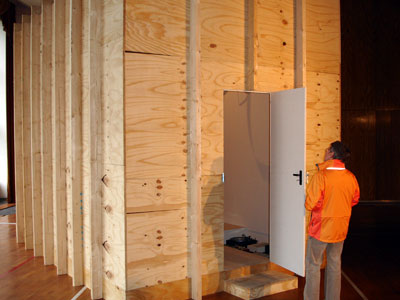
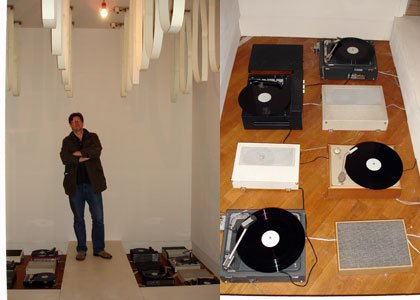
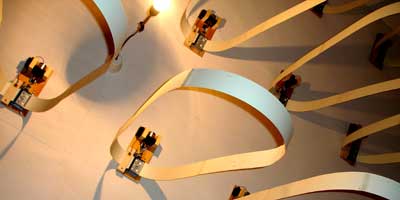
sonambiente berlin 2006 – akademie der kunste, pariser platz
As sonambiente berlin2006 is spread out throughout Berlin mitte, several large scale installations are located at both Akademie der Kunste in the old east and west of Berlin. Below are a selection of projects installed at Akademie der Kunste at Pariser Platz, on the old East side of Berlin. Their were several other projects, but I only documented the ones that I was intrigued by.
Near the entrance of Akademie der Kunste sits Jan-Peter E.R Sonntag “Modern Minimal Disco” where one stands on a round steel pedestal that feels as if it is hiding a giant subwoofer while bright lights shine on you as if you were the center piece of a photo shoot and if that isn’t enough attention behind one is a wall sized mirror with the listener as the focal point. The audio presents a narrative that follows a progression that reaches nerve wrecking peak while the pedestal rumbles under one’s feet, the lights shine and the listener begins to reach a club like ecstasy.
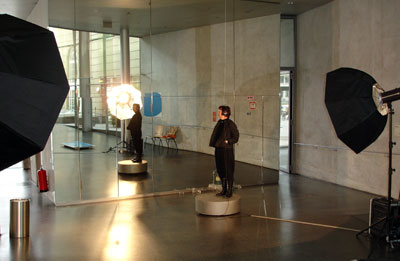
Jan-Peter E.R Sonntag “Modern Minimal Disco”
One room contains two works by Tilman Kuntzel – “Maintenance Measures for the SoundUnit Fan and Soundwall?” and “Sleep Capsule.” The first presents a wall of shelves with the adidas footballs designed for the 2006 world cups all listening via headphones to the matches played. Each ball represents a country playing in the world cup and each ball listens to its country’s games in its proper language. These audio broadcasts are being recorded and at the end of the World Cup Kuntzel will transform this recordings into an audio collage, I think largely composed of “GOAL” or “GOL” or “TOR”… and all the other forms of crying in happiness at one’s nation’s goal…
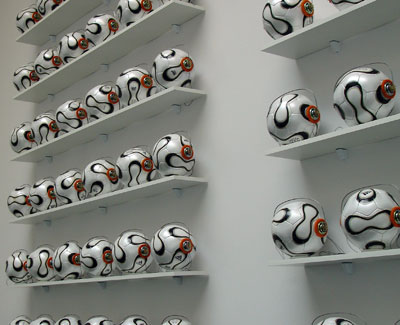
“Maintenance Measures for the SoundUnit Fan and Soundwall?” by Tilman Kuntzel
And across from this soccer balls sits an isolation room where one may lay down and escape all the hysteria of the World Cup.
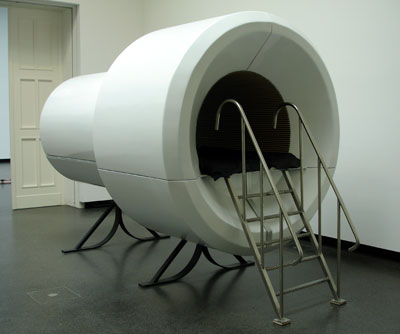
“Sleep Capsule” by Tilman Kuntzel
As one continues into the next gallery, elegantly installed is Bernhard Leitner’s Serpentinata II in which several speakers play their own solitary audio. As one moves from speaker to speaker, one feels as if s/he is moving through a sound scape. The sounds of each speaker are incredibly crisp and alluring.

“Serpentina II” by Bernhard Leitner
The highlight of this portion of sonambiente is Janet Cardiff and Georges Bures Miller “Opera for a Small Room.” As usual with this duo’s work they create an enthralling narrative with great technical skill. As I understand it, they have recreated the listening room of an opera lover. The individual may be a fiction, as the installation with exquisite surround sound, outside the reconstructed room tells a story composed of the records of the character. The installation becomes a bit Disneyesque with it’s thundering sound and flashing lights, for a moment it reminded me of Disneyland’s Tiki Tiki room in which the birds come alive and suddenly a terrifying storm comes along. I realize that this sounds like a negative critique, but in reality I absolutely love this piece, it is installation art, sound art, theater, fiction, beautifully created. Below is an excerpt of the artists description.
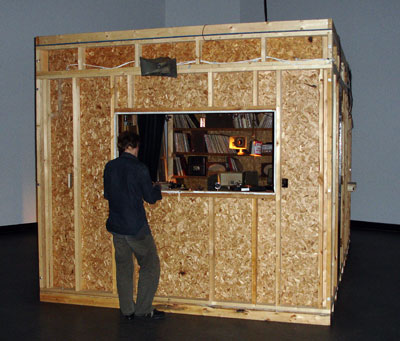
“Opera for a Small Room” by Janet Cardiff and Georges Bures Miller
“R. Dennehy lived most of his life in Salmon Arm, British Columbia, Canada. Not a lot is known about him, but he is listed in the telephone book as Royal Dennehy. One thing we do know is that he once collected opera records. He was infatuated with great tenors. We are aware of these facts because we bought all his records (which were signed at the top) at the second-hand store in Salmon Arm. There were approximately one hundred records. We are interested in the extreme cultural juxtaposition between opera and the smallwestern town in which R. Dennehy lived. What did he think about while listening to these records, recorded in cities half-way around the world? Was he a trained singer? Did he want to have a career in opera? Did he lose a lover and find solace in the music? Did he dream of traveling to faraway opera houses one day? We imagined him singing along to the records, creating his own opera, displaced in time and space. So we made a small room for the opera of his life. There are twenty-four antique loudspeakers out of which come songs, sounds, arias, and occasional pop tunes. There are almost two thousand records stacked around the room and eight record players, which turn on and off robotically syncing with the soundtrack.”
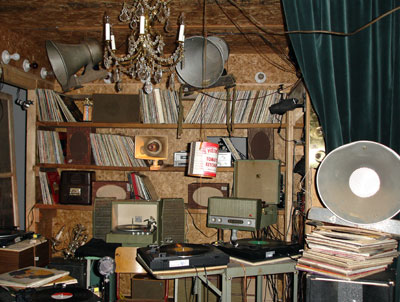
“Opera for a Small Room” by Janet Cardiff and Georges Bures Miller
tesla Berlin – center for media arts
tesla, a great space in the Berlin mitte, right across from Alexander Platz, is dedicated to the production and exhibition of new works encompassing installation, performance, sound and radio works.
Artists are given studio residencies and plenty of support to produce new works. As the directors of tesla, carsten seiffarth, detlev cutters, and andreas broeckmann, describe the art center:
“tesla is of Berlin laboratory for media arts; for the investigation of the relationship between art and science, old and new, analog and digital media; for open and process oriented artistic and technological research; for the dialogue with current form artistic practice; for the development of co-operation and networks” –
Currently tesla is in collaboration with the festival sonambiente Berlin2006 in presenting new audio and visual works and giving sonambiente artists, like myself a studio for production. Here are a few images taken at last Wednesday’s opening at tesla:
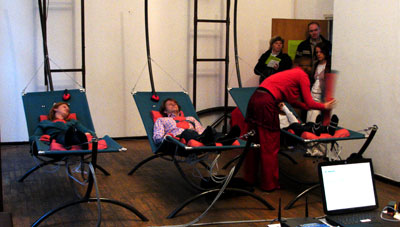
réactions épidermiques by lynn pook + julien clauss
Participants lay in these hammocks that have various points of stimulation – at the hands, feet, heart and ears sound and some sort of mechanical devices embedded in pillows titillate and relax the participant.
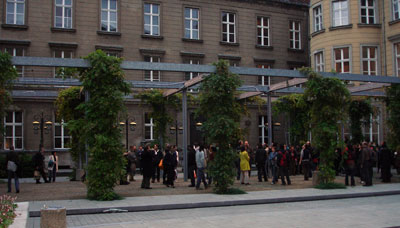
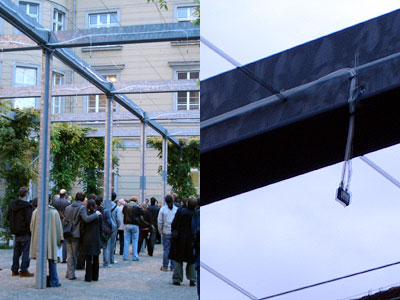
pneumatic sound field by edwin van der heide
Embedded in a large steel grid that is permanently part of tesla’s courtyard is Edwin Van der Heide’s sound installation. The sound is created from air shot through valves. The valves are mechanized and digitally controlled to play compositions. At first the compressed air instrument is relaxing, but over time becomes abrasive as one stands below or near the pneumatic sound field.
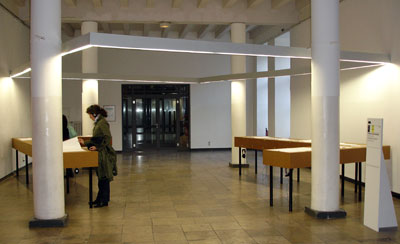
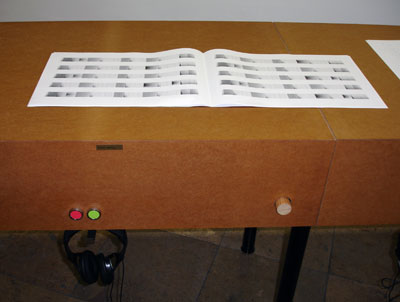
The wooden knob to the right is for the volume and red and green buttons are on/off – simple and elegant.
In the main lobby near the entrance of tesla is a work by graphic design students of the
Academy of Visual Arts, Leipzig. The students listened to electronic music compositions, by artists produced by the record label of Carsten Nicolai and then created visualizations of the audio. One may listen to the composition and study the visual designs by the students.
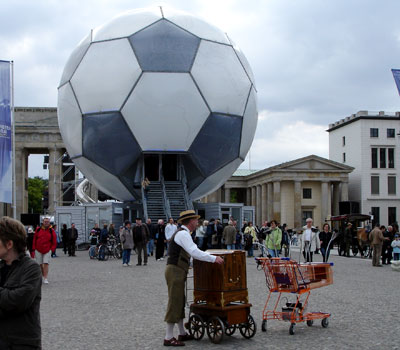
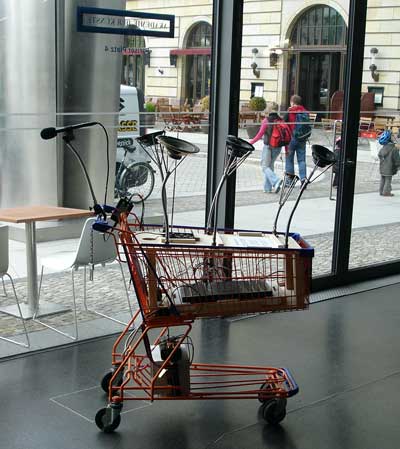
the public broadcast cart, miranda zungia
I have been given a studio at tesla, however my project, the Public Broadcast Cart is located at the Art Academy in the Paris Plaza, across from the giant soccer ball. The audio recorded when the cart is out and about will be edited and re-broadcast via the tesla radio – 1:1, 95.2FM Berlin.
On tesla’s second floor, in a dance/meeting hall space is the installation “fades” by carsten nicolai. Unfortunately it’s a very dark installation that is difficult to visually document. Light, smoke and sound come together to create the installation, as light projects through the smoke onto a large black screen to accompany a surround sound composition.
sonambiente berlin 2006 – Sound Art Floods Berlin
June 04, 2006
I’m in Berlin for the next six weeks participating in sonambiente, a sound art festival that is dispersed throughout the mitte of Berlin. And thus far this has been one of the most diverse and exciting festivals that I’ve witnessed. While the underlying theme is the creative use of sound, the festival is composed of performance, installation, radio, sculpture and public intervention and to boot the opening weekend is bracketed by the end of the Berlin Biennial and the beginning of the World Cup, what more could one ask for in one of the greatest cities of the world.
On the opening night I only made it to one third of the evening events, so I will begin with works documented that evening and progressively present documentation of other works over the next several weeks.
On the first of June, I made it to Allianzgebaude am Ostbahnhof, this is an office complex of which sonamiente took over the mezzane, second floor and fifth floor, in which artists were given offices and conference rooms to create installations. Appropriately this part of the exhibition is titled sonambiente_laboratorium, since many of the installations seemed unfinished, experimental or created by young artists in very hipster fashion.
Amongst my favorite works were:
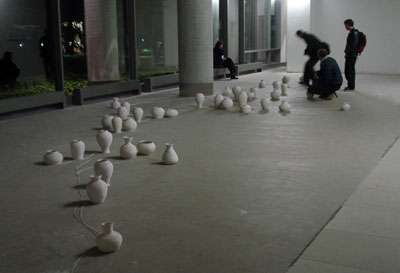
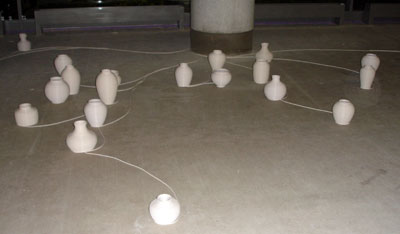
“Koexistenz” by Young-Sup Kim, 2006 in which the Korean artists recreates precious, traditional urns from white shelled audio cables that feed the audio into the speakers sitting within the urns. The urns are connected to play a multichannel composition of traditional Korean drumming created from household, everyday sounds. Perhaps I’m a romantic pushover, but I found this translation of two Korean traditions into contemporary art quite beautiful.
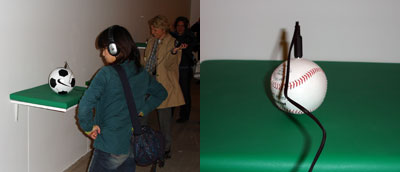
“The Perfect Shot” by Satoshi Morita, 2006 is whimsical, and very well produced. Various sports balls – soccer, golf, ping-pong, baseball sit one small green platforms with headphones plugged into the top center of each ball. Upon putting the headphones on, you hear all the sounds of the given sport from the ball’s perspective. Incredibly well produced, each audio composition presents crisp detail, from the soccer players feet running to the ball to swift kick and flight through the wind onto the next player or the ground and the scream and chanting of the arena. Or the baseballs release from the pitchers hand, through the wind, into the painful crash of the bat and through the air into a mit… Perhaps the funniest are the golf ball’s sounds of birds in the trees, and the wind rustling for a very long time, I left it before the swing of the golf club, and of course the back and forth of the ping pong. Each sound work captures the pace and excitement of the sport.
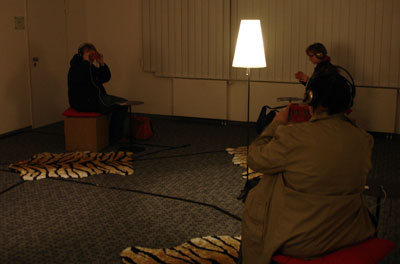
All be it not my favorite work, “3HfA,” 2006 by Iris Rennert and Oliver Friedli was amongst the stronger installations as the presentation effectively establishes a 60s mini lounge ambiance. Viewers enjoy 3D images through the viewfinders.

In very Ars Electronica fashion, here are two clear resin perhaps, well some sort of plastic with lots of electronics embedded collars that viewers may wear. Apparently based on the video documentation, when two participants wear the collars and walk toward one another, there’s a good bit of clicking from the collars. Perhaps best to review the website:
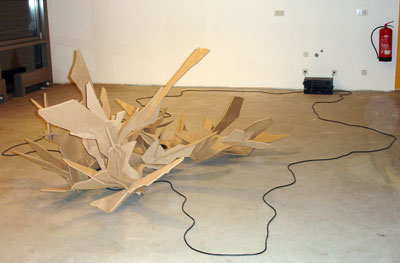
I didn’t understand this work, but there’s something interesting about it, perhaps the sounds that I didn’t record. It is an “Endless space for communications with myself – a vector based score series”
Here is one other installation that was visually nice:
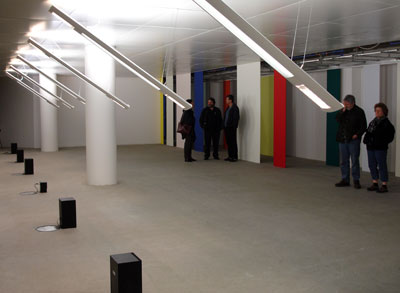
There were several other installations/projects and one performance that I didn’t document visually, since they were primarily concerned with sound.
Public Broadcast Cart in Berlin – June/July
May 19, 2006
From June 1st through July 17th, I will be participating in a sound art festival in Berlin – Sonambiente 2006. The festival organizers have invited me to participate with the Public Broadcast Cart – traversing the streets of Berlin. In preparation for the festival, I have revamped the project’s website, adding to the site lots of info that others may find useful, such as how to build your own cart. Keeping with the goal of the project as a tool for civil empowerment and to generate discussion surrounding increasing control of dissemination media by very few wealthy private entities the site is intended as an informational repository surrounding radio transmission in the hands of the public.
March for Peace, NYC 29 April 2006
April 30, 2006
As pointless as it seems with an untouchable Bush Administration, the protest march was lively and huge!
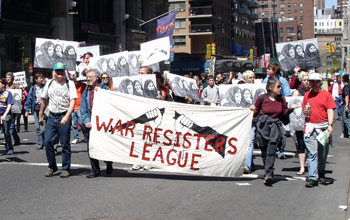

Communism alive and young in the U.S.
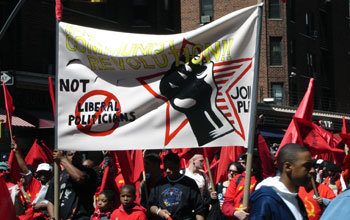
Considering an MFA
April 14, 2006
I’m currently teaching the senior BFA course leading to the students’ final exhibition. Most of the semester has been dedicated to professional development – resume building, press release, cover letters, fund raising, residencies… Last Wedensday however we discussed graduate school, as many of the students are interested in persuing an MFA. So I assemebled a presentation/discussion that I think anyone considering grad school might find helpful.
After discussing their personal interests in attending grad school, I pointed out the US News Ranking for Graduate Schools that they do every four years:
http://www.usnews.com/usnews/edu/grad/rankings/arts/artsindex_brief.php
http://www.usnews.com/usnews/edu/grad/tools/index_brief.php
Then I entered into my presentation/discussion based on personal experience:
Thinking About Grad School
It is helpful to consider Art in parallel to business or other professional areas in the sense that there are any number of ways of approaching a career in the Arts. Here are a few scenarios to consider to help you along in your decision process:
Location versus Program:Â “Do I go to a city with plenty of art and culture where I can use school to begin networking and launch me into an arts career in that city or do I go to a place where there may be less networking and the arts community may be smaller, but where I may have more time and space to focus and work?”
There are great programs where you will be able to focus, have a strong community with faculty and peers but are located in small cities, college towns or isolated rural areas. OR you may decide that being in a major city with a strong and diverse arts community comprised of a gallery district, several non-profits and available grants for artists is where you would like to go to grad school in order to begin to establish a lasting network, this primarily means schools in or near New York City or Los Angeles. To use graduate school as an introduction to the art world on a national or international scope is amongst the primary reasons that people choose schools in or near NYC and LA as many of the faculty may be represented by galleries in these cities and can help introduce one to the galleries. This of course can be particularly important to artists hoping to achieve an independent studio practice maintained by the sales of one’s work. This question may point to differences between a school that is gallery oriented versus teaching oriented.
Theory versus Practice focused programs:Â “Do I enjoy a research oriented practice informed by an understanding of cultural theory or do I prefer to jump right into the materials and allow the process to define the work?”
These two certainly are not mutually exclusive and less so as post-modernity is entirely indoctrinated into art instruction. However some schools will offer a strong theoretical underpinning to help develop the conceptual strength of your work and put less emphasis in technical instruction. These schools tend to be less conventional, have adopted a post-modern approach to art making and have little interest in craft. Here is an example of a description by/of this type of program:
This interdisciplinary program prepares artists of all genres—film and video, painting, performance and installation and sculpture—to successfully enter the contemporary art arena. A significant proportion of its alumni have achieved international and national reputations.
(Art Center College of Design, MFA description)
More traditional programs divide their areas by medium – one must apply to painting, or sculpture, or photography, etc. These schools may put a greater focus on technical skills and the development of one’s chosen craft and less emphasis on theoretical and conceptual background.
Strong craft oriented programs: Cranbrook Academy of Art, Michigan – http://www.cranbrookart.edu/
Alfred University
Where would you like to situate yourself in the arts:
Do you envision yourself as an artist working in a creative field with a company, such as a design firm, an ad and publicity company, an animation or film house…?
Do you envision yourself as an independent artist with a personal studio?
Would you seek to establish a relationship with a gallery?
Would you seek a teaching position to split your time between teaching and studio work?
Would you seek to maintain a studio through freelance work…?
Would you prefer to establish yourself as a regional artist with an emphasis in       establishing roots in a specific community?
Would you prefer to establish international credentials?
Would you prefer a studio practice versus a site specific practice versus a community       based practice?
Are you an object maker versus a time-based artist (performance, electronic arts)?
Check out real estate cost in the area
Financial Reality
The point of graduate school is to seriously focus in your work as an artist, without the dilemma and distraction of a full-time job. Consider grad school your full-time job, if you are unwilling to do so, it’s most likely not worth your money or time to attend a graduate school in Fine Arts. Look for programs that offer generous funding and positions as teacher’s assistant.
- Personal Suggestions:
- Take time off from school to test your dedication and perseverance – will you continue producing work without the framework of school?
- Be willing to live minimally or simply in order to give yourself time to continue developing your work without the strain of a full-time job.
- When it comes to applying to grad school ‚Äì research the faculty at the school, look at the work they have produced, look at the work of the current grad students, find information on the facilities, does the school provide generous funding for their graduate students, make an appointment to visit the school if possible, and of course request all their materials.
- Go to the program that offers you the most money, avoid debt if possible.
- With or without graduate school, a career in the arts requires a great deal of perseverance, dedication, and patience. It is important to establish sustainable systems for your work and yourself.
- It is useful to create for yourself a three year plan: where would you like to be in three years, what do you need to accomplish now to get to that point? After the first three years, evaluate where you are and your personal satisfaction/happiness/accomplishments and establish a new three-year program. Eventually the three-year plan may become a five-year plan.
Noteworthy Programs in the United States
The two “art centers”:
New York
Columbia University
City University of New York Hunter
School of Visual Arts (SVA)
Pratt Institute
Bard College, http://www.bard.edu/mfa/
Yale University
Rhode Island School of Design
NYU
Parsons
Los Angeles
University of California in Los Angeles (UCLA)
Art Institute
California Institute of the Arts
Art Center College of Design
University of Southern California (film)
Cities that are considered more “regional”:
Chicago
The Art Institute of Chicago
University of Chicago
San Francisco
San Francisco Art Institute
California College of the Arts
Mills College
San Jose State
San Francisco State
San Diego
University of California at San Diego
Boston
MIT
School of the Museum of Fine Arts
Minneapolis
Minneapolis College of Art and Design
Philadelphia
Pennsylvania Academy of the Fine Arts
Tyler School of Art
Temple University (Film and Media Arts)
The University of the Arts
University of Pennsylvania
Drexel University (digital media)
Pittsburgh
Carnegie Mellon University
Seattle
University of Washington
Smaller and rural areas:
Ames, Iowa
University of Iowa
Richmond, Virginia
Virginia Commonwealth University
Vermont College, Vermont Studio Center
Alternative Schools – meet only during the summer or limited periods
Bard (very hot!)
http://www.bard.edu/academics/programs/
Vermont College
http://www.tui.edu/current/ma/mfav/
Whitney Museum Independent Study Program, New York City (no diploma)
Schools with traditionally strong gallery associations
Yale
UCLA
Columbia
RISD
Bard
Schools considered strong for teaching
Carnegie Mellon University
Chicago Art Institute
UCSD
Post-Baccalaureate Art Programs
The Art Institute of Chicago
Maryland Institute College of Art (MICA)
http://www.mica.edu/PROGRAMS/postbac/
University of the Arts (in crafts)
Programs in Digital / Experimental Media and the Cultural Study of New Media
Film and Communication Studies Programs in Canada / Programmes de cinéma et communication au Canada
http://www.film.queensu.ca/FSAC/Schools.html
University of California at San Diego, Visual Arts
http://visarts.ucsd.edu/
Rensselaer Polytechnic Institute, Electronic Arts
http://www.arts.rpi.edu/index02.php
San Francisco State University, Conceptual Information Arts (CIA) Program
http://userwww.sfsu.edu/%7Einfoarts/
School of the Art Institute of Chicago, Art & Technology Studies
http://www.artic.edu/saic/programs/depts/graduate/ats.html
UC Irvine – ACE, Arts, Computation, Engineering
http://www.arts.uci.edu/article.php?nav_id=29&nav=29
http://www.ace.uci.edu/
Georgia Tech
School of Literature, Communication, and Culture
http://www.lcc.gatech.edu/index.html
Graphics, Visualization, and Usability (GVU) Center
http://www.cc.gatech.edu/gvu/gvutop.html
Carnegie Mellon University
Human-Computer Interaction Institute
http://www.hcii.cmu.edu/
Art Department
http://artserver.cfa.cmu.edu:8080/
Mass Institute of Technology (MIT)
the Media Lab
http://www.media.mit.edu/
Art Department
University at Buffalo
Media Studies Department
http://mediastudy.buffalo.edu/
University of Iowa
Department of Cinema & Comparative Literature
http://www.uiowa.edu/%7Ecomplit/
